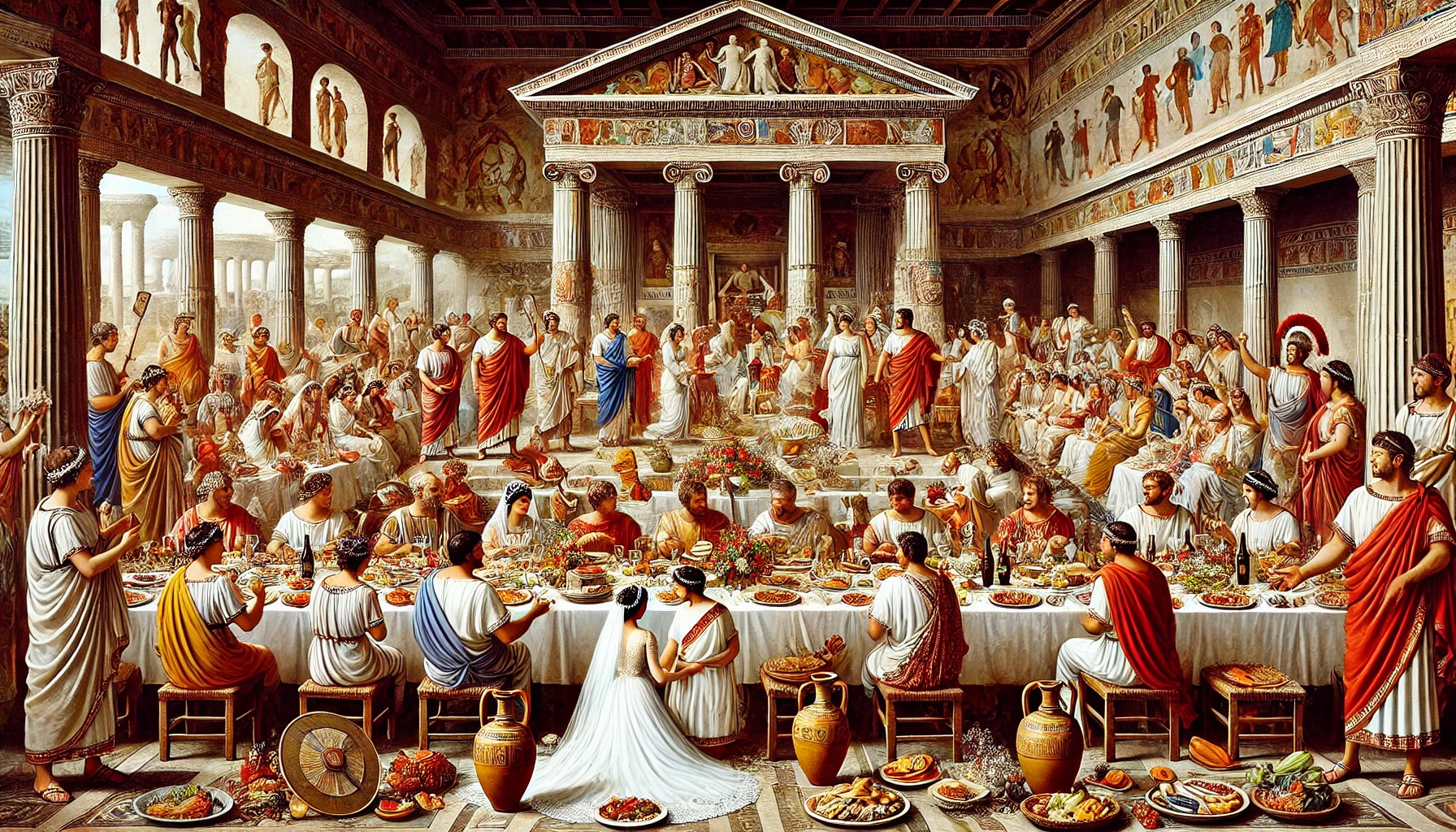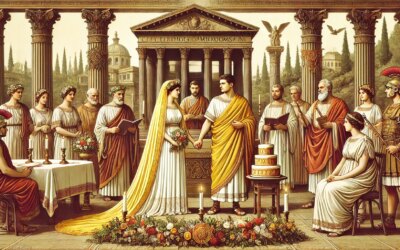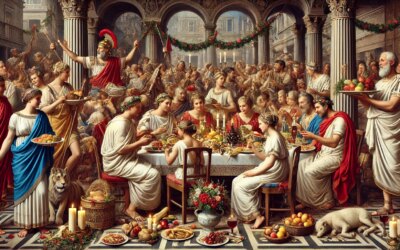Binding Hearts and Houses in Ancient Rome
In the shade of a Roman villa’s courtyard, musicians strike up a joyful melody. Friends and relatives gather around long tables laden with wine, fruits, and honey cakes. At the center of it all, a bride and groom sit side by side, wrapped in togas and wreaths. This is a Roman wedding feast in the 1st century AD—a celebration not just of love, but of law, lineage, and the gods.
Marriage in Roman Society
Marriage in ancient Rome was more than a romantic union—it was a civic and social contract. It connected families, secured property, and produced legitimate heirs to carry on the family name. Among the upper classes, marriage also served political purposes, forging alliances between powerful families.
Three main forms of Roman marriage existed:
- Confarreatio – A sacred, aristocratic marriage performed with religious rites and the sharing of a spelt cake. It was reserved for patricians and involved the Flamen Dialis and the Pontifex Maximus.
- Coemptio – A symbolic “purchase” of the bride, often involving a copper coin and scales.
- Usus – A less formal arrangement achieved by cohabitation for one year, unless interrupted by the wife staying away for three nights (preserving her independence).
Preparations and Engagement
Marriages were usually arranged by families, with betrothal (sponsalia) ceremonies confirming the agreement. These included a formal promise, exchange of gifts, and often a ring placed on the third finger of the left hand—a tradition that survives today.
Girls typically married between ages 12 and 15, while grooms were often in their twenties or older. Before the wedding, omens and astrologers might be consulted, and the bride prepared with ritual baths and offerings to household gods.
The Wedding Day
The Roman wedding began at the bride’s house with prayers to Juno, goddess of marriage. She wore a white tunic bound with a special knot—the “knot of Hercules”, symbolizing fertility and strength—and a bright orange veil (flammeum), secured with a garland of flowers. Her hair was parted with a spear, a vestige of ancient rituals connecting marriage to conquest and tradition.
The groom arrived with a procession, often accompanied by torchbearers, musicians, and guests. A ceremony at the bride’s altar included vows, sacrifices, and the symbolic joining of hands (dextrarum iunctio), affirming mutual consent.
The Wedding Feast
Following the ceremony, a lavish banquet ensued. Tables overflowed with roasted meats, fresh bread, olives, cheese, fruits, and cakes. Wine flowed freely, often mixed with honey or herbs. Entertainment included musicians playing lyres and flutes, dancers, and recitations of poetry.
Feasts varied based on wealth and region, but even modest weddings included some form of communal meal. The sharing of food symbolized unity and abundance, while toasts and speeches celebrated the newlyweds’ future.
Procession to the Groom’s House
As evening fell, the bride was led in procession to her new home. This symbolic journey was accompanied by torches, flutes, and loud shouts of “Talassio!”—a traditional exclamation invoking blessings on the union. Guests threw nuts and coins, and children carried protective charms to ward off evil spirits.
At the groom’s threshold, the bride was lifted over the door—a gesture meant to avoid ill omens and symbolically sever her ties to her old home. Inside, she lit the hearth fire, marking her new role as mistress of the house.
Symbols and Superstitions
Roman weddings were rich in symbols and rituals meant to ensure fertility, harmony, and divine favor. Common practices included:
- Using sheep entrails or sacred chickens to check for good omens.
- Avoiding weddings on certain unlucky days, such as the Kalends of January or the Ides of March.
- Grooming the bride with six tresses, invoking the number’s sacred power.
- Burning offerings at household altars before the ceremony.
These customs reflected Rome’s blend of religion, folklore, and family duty, ensuring that marriage was not merely private—but cosmic and cultural.
After the Wedding
The day after the wedding, the couple visited temples—often to Juno, Vesta, or Venus—to give thanks and seek favor. For wealthier couples, gifts from clients and political allies were common, while the family held additional banquets or entertainments for several days.
Legal documents and dowries were finalized, and the marriage registered by local authorities. Inheritance rights, citizenship benefits, and family status were all influenced by this union.
Legacy and Influence
Many Roman wedding traditions echo in modern ceremonies—rings, veils, processions, and banquets. The Roman view of marriage as both a legal and sacred act influenced Christian doctrine and Western civil law. Even the phrase “tying the knot” harks back to the knot of Hercules, once fastened around Roman brides.
Marriage as a Mirror of Rome
In the Roman world, marriage was a moment of continuity—a way to preserve names, values, and property through generations. From modest homes to imperial palaces, weddings reinforced the social order, honored the gods, and celebrated human connection. In laughter, music, and vows, the ancient Romans found a way to make love not only personal, but profoundly public.






